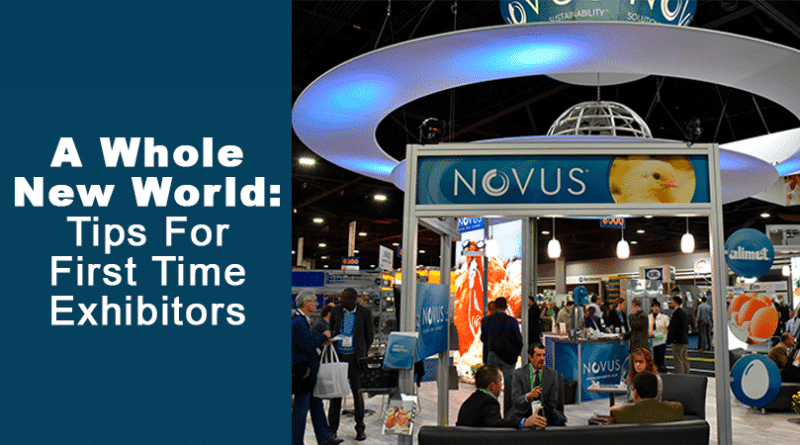New To The Trade Show Exhibiting World?
Being a newbie to the world of trade shows can seem overwhelming at times, especially if you are an exhibitor. You will be helping to transform an empty space into an exhilarating environment where you and your staff can teach, display and entertain, all while trying to connect with your valued customers and new prospects.
We have tried to make it just a bit less daunting by discussing some important items to consider when delving into your first exhibiting experience.
TRAVEL PLANS IN ORDER
Travel as light as possible, but take all you need to function on your trip.
A hotel is just as important as locking down your booth. As soon as you’ve finished securing your exhibitor space, make sure you’ve obtained lodging for you and your team. There may be plenty of hotels in the area, but wouldn’t you rather spend time networking rather than shuttling back and forth between the conference and your hotel?
Know the location of your hotel in relation to the venue and the airport. In some cities, renting a car makes sense, in others you’re better off taking a cab or shuttle. If you’re planning to take mass transit, know where to get on and how to get to where you’re going. Mapping tools on your smartphone are great for directions; so make sure your phone is charged, and even bring a small charger with you.
DATES & DOCUMENTS
Make sure you’ve registered your team and not just you for your booth. You will be given a set amount of pre-registrations, but it’s up to you to get your team prepared. Be sure to use each team members’ individual email address for his/her registration. Do not use a general email for each registrant, because you want to make sure that every team member receives emails laying out the day’s schedule and special events. This will keep everyone on your team independently informed.
Once you’ve registered, you’ll be receiving a lot of info from the conference. One piece of that info to look out for is the “quick facts”. It will tell you everything about registration, load-in and load-out regulations, submission deadlines and more. Put these events in your calendar so you don’t miss a thing and can plan accordingly.
Make sure to double check all those show documents to make sure you have dotted your “i’s” and crossed your “t’s.” Don’t forget to bring all those documents, emails and contact numbers, etc. to the show with you. Some trade show companies, like ours, offer services to help relieve the stress of this paperwork and ensure all these documents are in order. You may want to consider this service, as your plate is full of many other tasks.
Most big shows have apps or online tools to allow you to create a show plan. These apps allow you to add exhibitors/booths, ultimately creating a list of what to see and where. Do this a week or so before the show. If there are educational sessions, create a plan for those you’ll be attending. When at these events, you’ll often have time to meet other attendees and do a little networking as well.
TRAINING – STAFF
Almost 80% of what visitors remember about their exposure to your exhibit is their interaction with you and your staffers (CEIR). The large budgets invested in a trade show can be for naught if staff members aren’t trained to present your message accurately.
If you’re bringing other people from your company to the show, put your best people on the job. People will naturally react positively to people who are well groomed, wearing nicely laundered/ironed clothes and smiling. On a side note, it is inevitable that the show floor hall will always either be too cold or hot, so dressing in layers gives you the opportunity for optimal comfort at all times. Wear comfortable clothes and shoes; you are going to be on the floor for a while.
Make sure everyone working your booth knows the targeted attendee groups, key individuals within those groups – and engages them in conversation, determines interest, delivers the message clearly, and collects a lead – all within a compressed amount of time.
Selling at a trade show is different than other selling that your staff may be used to. Don’t just sit there like a bump on a log when people walk up to your booth! Take an interest in each visitor, even if you’re with another customer, take the five seconds to make eye contact and say, “I’ll be right with you.” Unless you’re selling the best product ever invented, people won’t buy from you if they get the impression you don’t care. On the flip side, never initiate the conversation with a long-winded or pushy sales pitch. If people seem interested, then take a minute to talk to them and uncover their reasons for seeking you out. You should find the delicate balance between engaged and aggressive.
THE BOOTH
When you register to exhibit, note the booth size and style of space you received also making sure your exhibit, marketing materials and banners fit accordingly. Have the design drawn out to scale and regulations. A trade show display company can help you with this. Does it look too crammed? Is it inviting? Does it stand out? Does your booth represent you and reflect your brand? Your booth is the second most important factor (behind interactions with booth staffers), be certain the environment is conducive to business. The exhibit should be attractive, clean and current. If you’re making do with an older booth, you may be doing your company a disservice. Don’t skimp on graphics; they are critical to telling your story effectively.
Triple check that your company objectives are clearly represented, especially if you offer a complicated or specialized service. It’s not fair if people have to question you to find out who you are; plus, some of them may be deterred from your lack of identification and never approach at all.
This may seem strange, but people will nearly fight each other for a place to sit down and rest, and you can use this to your advantage. Make space at your booth to invite people to sit when they need a break. People will be more likely to converse with you if they’re relaxed. On the other spectrum, this is not an invitation for all your staff to sit. You need be alert and engaged in the booth. Save the seating for your prospects and clients.
SOCIAL MEDIA
Conference hashtags are not only for just during the conference. You should use it before and after the event as well. Let your audience know that you’re preparing to come or that you just enjoyed being there. Use them to connect with attendees and to secure traffic to your exhibit before the conference even begins. During the conference, you can retweet other exhibitors, tag attendees on Instagram or update your professional network on LinkedIn. After the conference, view the hashtag on all platforms and connect with everyone who attended. It’s a fast an easy way to build some meaningful relationships.
FOLLOW UP
As an exhibitor, you will receive a lot of attention, and you will also receive a lot of contact information. The only way you can capitalize on all those contacts is to follow up with them. Post-show is often one of the biggest failures. Leads must be followed up on immediately. It is important to know the interest of the lead and be able to take that the relationship to the next level in the sales process. There’s nothing wrong with adding your new contacts to a bulk email list, but how personal does that really seem? You may only get one chance to reconnect. Make sure it counts!
At the close of the show, sit down with your staff to review successes and failures. This is also the opportunity to analyze leads and assign follow-up.
It can be difficult to determine ROI (return on investment) for trade shows. Leads may take months or years to convert to sales. It can also be challenging to quantify the value of retaining and continuing sales to existing clients you meet with during a show.
Determining the ROO (return on objectives) may be a better objective. This could include achieving key metrics for meeting with existing clients, capturing leads for new customers, quality of leads, press coverage, advanced training for staff, or competitive insight/analyses.
In the end, no matter what direction exhibiting ends up taking you, don’t waste efforts by showing up without a plan. Unpreparedness leads to chaos and then to frustration, which won’t help you to attract new clientele. Organize, stay calm and then get out there and market yourself and your company the successful way.
Article Written by Krista Kaegbein, Creative Director at PRO Expo Exhibits



